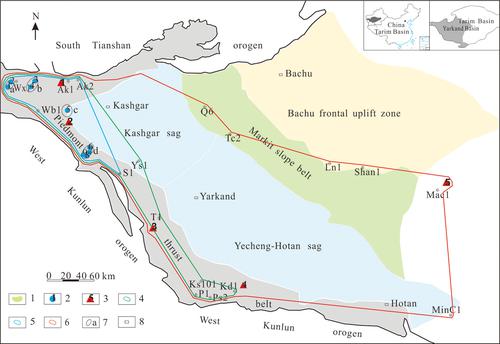当前位置:
X-MOL 学术
›
Acta Geol. Sinica Engl. Ed.
›
论文详情
Our official English website, www.x-mol.net, welcomes your
feedback! (Note: you will need to create a separate account there.)
A Rapid Marine Regression in the Southwestern Tarim Basin in the Latest Cretaceous: Comparison of Two Different Evaporitic Sequences in the Yarkand Basin, Xinjiang Province, China
Acta Geologica Sinica-English Edition ( IF 3.5 ) Pub Date : 2021-03-30 , DOI: 10.1111/1755-6724.14703 Yangtong CAO 1 , Changmin ZENG 2 , Liang ZHANG 2 , Lichun ZHU 2
Acta Geologica Sinica-English Edition ( IF 3.5 ) Pub Date : 2021-03-30 , DOI: 10.1111/1755-6724.14703 Yangtong CAO 1 , Changmin ZENG 2 , Liang ZHANG 2 , Lichun ZHU 2
Affiliation

|
Two different evaporitic sequences occurred in the latest Cretaceous–Early Paleocene in Yarkand Basin, southwestern Tarim Basin, Xinjiang Province, China: one is characterized by poor gypsum and some small, lenticular-shaped halite layers in the Tuyiluoke Formation of the latest Cretaceous, the other is characterized by very thick gypsum and halite layers in the Aertashen Formation of the early Paleocene. In the early developmental stage of the Tuyiluoke Formation, the Yarkand ancient saline lake was a long, strip-shaped depression, NW–SE oriented, along the West Kunlun piedmont, with its eastern boundary to the line along bores Ys1-T1-Ks101, the concentrated center located in the area of borehole S1. In the later developmental stage, the depositional scope was shifted inch by inch to the NW of this saline lake, forming a triangular depositional area, with apices at boreholes Wx1, Ak2 and S1, the concentrated center of the saline lake gradually migrating from borehole S1 region to the northwestern area of the lake, developing four small, evaporated-concentrated sub-depressions, depositing lenticular-shaped halite. In the early Paleocene, the ancient saline lake was stretched from the West Kunlun piedmont in the west, to the Markit slope in the east, from the South Tianshan piedmont in the north, to the Hotan area in the south, accompanied by giant thicknesses of halite and large-scale gypsum layers, mainly interbedded with limestone in the Aertashen Formation. The evaporites in the latest Cretaceous-early Paleocene were controlled by the marine transgression-regression geological background in the Yarkand Basin. Generally, integrated evaporitic depositional sequences, such as clasolite-gypsum-halite-potash, usually occur in the presence of persistent seawater through evaporation, but this is not the case in the Tuyiluoke Formation. In contrast, very thick gypsum layers are common in the early Paleocene. Typically, adequate mineral sources for evaporites are found within seawater, such as in large basins undergoing long-term marine transgression-regression cycles, where adequate seawater remains, even though the basin was going through a marine regression stage. In the latest Cretaceous, thin gypsum layers indicate a lack of mineral sources. In contrast, the early Paleocene has far larger evaporites, both in width and thickness. This suggests a short-term marine regression stage must have occurred during the spatiotemporal evolution of the evaporites in the latest Cretaceous–Early Paleocene in the basin, meaning that a rapid marine regressive episode has been identified at the end of the Cretaceous.
更新日期:2021-03-30











































 京公网安备 11010802027423号
京公网安备 11010802027423号